These notes on the sundials of Tasmania were written by Piers Nicholson
in January 2001. This trail is dedicated to Roy and Clodagh Harden-Jones
with many thanks for making our visit to Tasmania so enjoyable.
Though Tasmania appears to have very few sundials, these two are of considerable
interest.
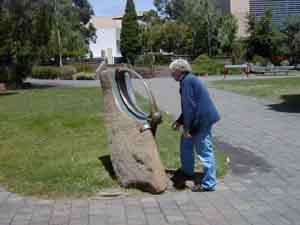
|
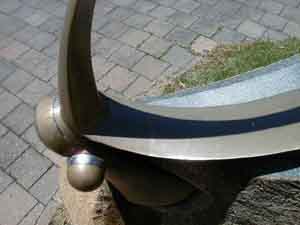 |
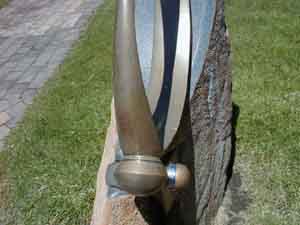 The sundial is in the central pedestrian open area of the main University
of Tasmania Campus in Sandy Bay.Walk south along Grosvenor Street
into Grosvenor Crescent. After about 50 metres, turn right to walk
up the steps between the two sections of the Centennial Building
to the open area at the centre of the campus. The sundial is on
to the left of the path.
The sundial is in the central pedestrian open area of the main University
of Tasmania Campus in Sandy Bay.Walk south along Grosvenor Street
into Grosvenor Crescent. After about 50 metres, turn right to walk
up the steps between the two sections of the Centennial Building
to the open area at the centre of the campus. The sundial is on
to the left of the path.
It consists of a dial plate attached to the stone plinth, and a
rotating upper segment controlled by two solid wheels shown in the
photograph. The dial plate is marked out with an analemma, marked
up with the months of the year. The rotating segment has a home
(nodus) permitting a spot of light to shine through it. You turn
the solid wheels until the spot of light falls on the vertical through
the current date point on the analemma, and then read off the hours
on the larger wheel and the minutes on the smaller one. It is a
very ingenious and interesting design. |
The sundial pictured below has been described as "the most interesting
sundial in Australia" and it is also one of the oldest. It is the war
memorial in the centre of Bothwell, which is on the Lakes Highway north
of Hobart. The memorial has a sundial on all 4 of its faces. The pictures
show the northern face with the equation of time plate below it, a close-up
of this face, and the southern and eastern faces, with the plaques recording
the names of those who went to the war.
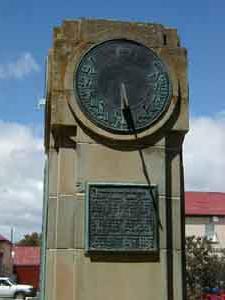 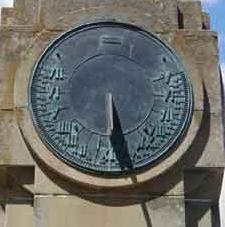
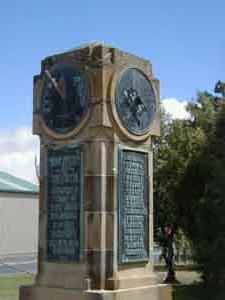
And these pictures show close-ups the dial on the eastern face, with its
gnomon parallel to the dial plate, and the equation of time plate, which
has become somewhat damaged.
.
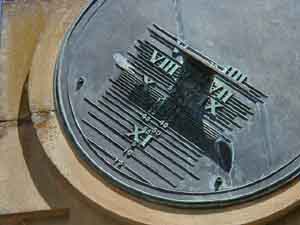
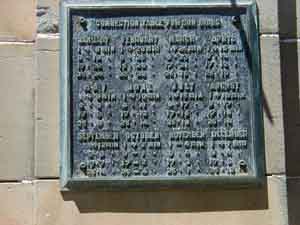
Recently, a new Transit of Venus sundial has been built in Campbell
Town Campbell Town is a major pastoral, wool-growing and tourist centre
in the Northern Midlands of Tasmania, situated on the Heritage Highway,
134 kms from Hobart, and 68 kms from Launceston.
This sundial was designed and built by Anthony Sprent in 2004 for Campbell
Town to commemorate the transit of the plant Venue across the face of
the Sun, first observed at The Grange by scientists form the United
States Naval Observatory in 1874. This event occurs approximately every
120 years. The latest transit took place on the 8th June in 2004, and
will recur in 2012. The next pair of transits will take place in 2117
and 2125.
The sundial is made form old agricultural machinery located from properties
in the Campbell Town area. The design reflects the rural connections
of the town and the historical significance of the astronomical observations
made here in 1874.
To use the dial, sit in the seat then rotate the hand-wheel until the
plough disc is facing the sun. Adjust the disc until the light of the
sun through the small hole in front of the disc is shining on the line
of dots engraved nearest the current month of the year. Now read the
time displayed on the scale. The date is given by counting the number
of dots since the beginning of the moth to the dot where the sun is
shining.
(Many thanks to Frank O'Connor for these details and pictures)
|
 For
a full overview click here
For
a full overview click here  For
a full overview click here
For
a full overview click here 



